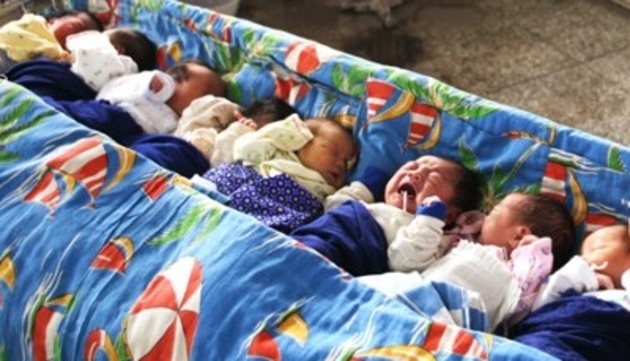New births slipped 15% across China in 2020 despite stay-at-home lockdowns and state media baby-making cheerleading, Asia Times writes. During China’s de facto nationwide lockdown in early 2020, when Beijing issued a sweeping shelter-in-place edict to stop the spread of Covid-19 from Wuhan, state media Xinhua entertained the thought that a “Covid lockdown baby boom” could be one upside. The new coronavirus forced the Chinese population, including couples in their prime ages, indoors, it noted.
“What would you do during prolonged homestays and when working from home?” asked an opinion piece run by the official news agency in March 2020. “Newlyweds and couples in their 30s or 40s in Wuhan and other locked down cities may make good use of the commuting time saved to cement ties and procreate.”
Xinhua’s “Covid baby boom” forecast failed to pan out. Indeed, preliminary figures from the nation’s ongoing population census now suggest a “Covid baby bust” in China.
The world’s most populous country saw a 15% slump in registered newborns, from 2019’s 11.79 million to 2020’s 10.03 million.
The worrying 15% drop in new birth registrations was not revealed by the National Statistics Bureau, which has sought to hold back demographic figures when announcing economic and social development data for the year.
At a State Council press briefing on January 18, NSB’s director Ning Jizhe failed to answer when asked by reporters if the anti-Covid measures of a year earlier had spurred a tide of new births across the country in September and October of 2020.
He was also asked if the findings of the census, held once every decade since 1949, would increase the prospects – as top policymakers had hoped – that “a decent increase” in the numbers of China’s younger people would follow Beijing’s 2015 revocation of draconian family-planning laws, known as the one-child policy.
But Ning dodged that question, too, saying that all statistics from the census would be made public in April or at a later date to be announced as the NSB needed more time to crunch and analyze numbers.
It was instead the Ministry of Public Security that outed the disparities between newborn dreams and realities in its work report for 2020. The ministry is responsible for new birth registration and also is involved in the nationwide headcount operation.
The ministry’s register of new births shows that among the 10.03 million babies born in China last year, there were only 4.74 million girls. It also shows that the peak birth count in the past decade, 17.86 million births, came in 2016 – the year immediately after Beijing abolished the one-child policy.
Demographers now warn of more worrisome figures when the census’s final reports are released in the second quarter.
Figures compiled by a number of local authorities during the current population count and reviewed by Asia Times also paint a gloomy population production picture in both well-off cities and western regions, where babies are becoming a rare and even endangered species.
For instance, Shanghai, China’s largest urban center with more than 24 million residents, on the first day of 2021 reported only 156 newborns whose mothers had the city’s hukou, or permanent residency.
Non-local pregnant women are normally not allowed to deliver at Shanghai’s public hospitals and the inflow of migrants from elsewhere across China is stemmed by the high threshold for obtaining the city’s hukou. Thus, Shanghai’s newborn figures are seen as a ballpark indicator of the city’s population production.
Shanghai’s statisticians also revised downward the city’s total births in 2020, from about 96,000 to fewer than 80,000, based on the latest figures from the census, which showed some district governments had sought to cook the population books by massaging new birth figures.
In December, Shanghai’s Xinmin Evening News quoted figures from a Pudong district government survey indicating that about a third of newlyweds in the affluent financial district in the first three quarters of 2020 said they would choose the DINK way of living, either permanently or for the initial years after their marriage.
Not only were they lured by the dual-income-no-kids lifestyle. They also dreaded facing parental and homeowning obligations in mainland China’s most expensive city.
In the coastal city of Ningbo, China’s largest maritime transportation hub, 36,000 new births were recorded in 2020, down 20%. In Hefei, capital of the eastern Anhui province, newborns decreased by 23% to 79,300 last year. Hefei is a city of close to 10 million dwellers.
In the Muslim-dominated far west autonomous region of Ningxia, the seven million-plus residents had fewer than 80,000 babies in 2020, down 16% – even though China’s ethnic minorities in Ningxia are exempted from Beijing’s existing birth control rules that limit the number of kids each couple can have to two.
The northeastern backwater province of Jilin, grappling with the nation’s lowest birth rate and a constant brain drain to coastal provinces, has even stopped publishing annual changes to its population figures. It has removed related statistics from the databases that used to be accessible by the public.
Thus far the direst warning is from the National Health Commission’s Center for Population and Development Research. Its latest studies published in January, based on mathematical models and past population growth trajectory, found that there would be fewer Chinese starting from as early as 2027, when the size of the population would peak at 1.417 billion.
That report said the gross birth rate would slip from 1.76‰ in 2020 into negative territory in or before 2027, and farther down to -2.18% around 2035.






